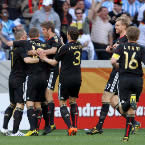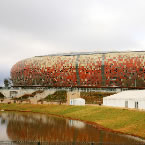South Africa has delivered on its promise to get all 10 World Cup stadiums finished despite scares caused by labor problems and construction holdups.
Now it is in a race against time to complete road, rail and transportation projects and is struggling to find enough suitable rooms to accommodate the homegrown fans and expected 450,000 visitors from overseas.
So much is at stake for the nation flying the flag as Africa's first to stage either a World Cup or an Olympics. Now that the building and refurbishment of the stadiums are complete, South Africa at last has something to brag about.
"It is a special moment for the country and we want the world to see our country through different eyes," said organizing committee chief executive Danny Jordaan, the man who has had to deal with most of the criticism about delays, lack of transportation and the country's alarming crime rate.
"The challenge is to shape the concept of how the World Cup will look.
"What is our mission? What do we want to achieve? Part of it is to ensure our country is a better place."
But there is a lot more to do in the final few months before the June 11 kickoff at Soccer City, which will be full to its 87,000 capacity when the host nation faces Mexico in the opening game.
Little more than a year before the start of the World Cup, the impressive Soccer City sat in the middle of a building site.
So did Mbombela Stadium in Nelspruit while the spectacular 70,000-capacity Green Point in Cape Town towered above the still to be bulldozed greens and bunkers of the small golf course it replaced.
With the Nelson Mandela Bay Stadium overlooking a lake, organizers in Port Elizabeth admitted it was a major challenge ripping up existing roads and replacing them with others wide enough to deal with the traffic taking fans to the 45,000-seat "Sunflower," so-named because of its eye-catching roof.
They also have such a shortage of rooms in Port Elizabeth that they are relying on accommodation up to 150 kilometers (92 miles) away.
Ray Whelan, an England-based FIFA consultant who is dealing with accommodation, ticketing and hospitality, said fans will have to get used to long journeys.
"You have to know the nature of the beast you are working with and South Africa is a huge country," Whelan said.
"In Germany in 2006, I know three (English) guys who went to three World Cup games and their wives didn't know they'd left. They got back the next day on the first plane they could. They'd sleep on the grass, they'd sleep in the nightclubs.
"I'm not saying they couldn't do it here. But I think the numbers that would take those steps are not great by any means."
Fans who show up planning to sleep in camp sites and believing that T-shirts and shorts are enough to wear will be in for a shock.
Although South African winters are usually dry and the days are warm, Johannesburg, Pretoria, Bloemfontein and Rustenburg are bitterly cold at night - down to minus 2 degrees Celsius (28 degrees Fahrenheit) in some places.
The 10 stadiums are in nine cities with two of them - Soccer City and the long established 62,500-seat Ellis Park - in Johannesburg.
Loftus Versfeld, like Ellis Park another bastion of rugby, is less than an hour's drive away in Pretoria and holds 50,000.
The privately owned Royal Bafokeng Stadium, built on the income made from the world's largest platinum mines, is in Rustenburg, which is 165 kilometers (100 miles) northwest of Johannesburg but lacks the nightlife of the big cities.
Bloemfontein lies almost in the center of South Africa and has another rugby stadium modified for the World Cup and with a slightly expanded 45,000 capacity.
All those cities are at altitude, as are the two World Cup venues in the north, Nelspruit and Polokwane, which are in the direction of Kruger National Park. That means teams will have to handle the thinner air at altitude and then go to sea level to play at the ports of Cape Town, Durban and Port Elizabeth.
Of the 10 stadiums to be used, perhaps the one at Durban is the most spectacular.
The 70,000-capacity Moses Mabhida Stadium has a Y-shaped arch which is 106 meters (350-feet) high in the middle. It has a 560-step walkway up to its highest point, which has a viewing area, and those not wanting to walk can take a cable car.
Like Johannesburg and Cape Town, however, Durban has its crime problem. Although mainly restricted to the townships, tourists can be targeted, especially if alone or at night.
Jordaan said that South Africa's record in safely hosting major events is good, however.
"South Africa has hosted 140 world-class events since 1994 without a single problem, including (the 2009) Confederations Cup, the cricket and rugby World Cups and many other major international events without any trouble," he said.
"We have done our homework at making sure fans, teams and officials will be safe at match venues and training grounds."


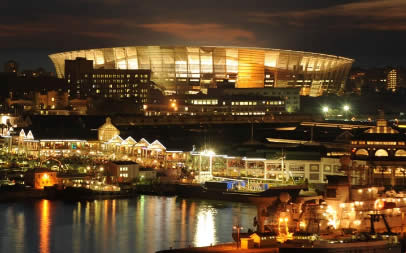




 For
all your Football tickets and events from around the globe be sure to check
out Finaltickets.com. Specialising in tickets that are normally considered
hard to find. We have the lot so dont forget that's www.finaltickets.com.
Click here to visit
For
all your Football tickets and events from around the globe be sure to check
out Finaltickets.com. Specialising in tickets that are normally considered
hard to find. We have the lot so dont forget that's www.finaltickets.com.
Click here to visit 




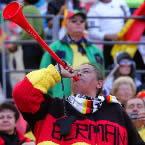

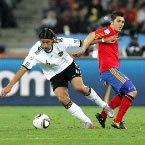
.jpg)


